
Kronborg is a castle and stronghold in the town of Helsingør, Denmark. Immortalized as Elsinore in William Shakespeare's play Hamlet, Kronborg is one of the most important Renaissance castles in Northern Europe and was inscribed on the UNESCO's World Heritage List in 2000.

Halland is one of the traditional provinces of Sweden (landskap), on the western coast of Götaland, southern Sweden. It borders Västergötland, Småland, Scania and the sea of Kattegat. Until 1645 and the Second Treaty of Brömsebro, it was part of the Kingdom of Denmark. Its name means Land of Rocky Slabs referring to the coastal cliffs of especially the northern part of the region.

Halland County is a county (län) on the western coast of Sweden. It corresponds roughly to the cultural and historical province of Halland. The capital is Halmstad. Prince Julian, the son of Prince Carl Philip, is Duke of Halland.

Skåneland or Skånelandene (Danish) is a region on the southern Scandinavian peninsula. It includes the Swedish provinces of Blekinge, Halland, and Scania. The Danish island of Bornholm is traditionally also included. Skåneland has no official recognition or function and the term is not in common usage. Equivalent terms in English and Latin are "the Scanian Provinces" and "Terrae Scaniae" respectively. The term is mostly used in historical contexts and not in daily speech. In Danish, Skånelandene is used more often. The terms have no political implications as the region is not a political entity but a cultural region, without officially established administrative borders.

Götaland is one of three lands of Sweden and comprises ten provinces. Geographically it is located in the south of Sweden, bounded to the north by Svealand, with the deep woods of Tiveden, Tylöskog and Kolmården marking the border.

The Treaty of Roskilde was negotiated at Høje Taastrup Church and signed (NS) during the Second Northern War between Frederick III of Denmark–Norway and Karl X Gustav of Sweden in the Danish city of Roskilde. After a devastating defeat, Denmark–Norway was forced to give up a third of its territory to save the rest, the ceded lands comprising Blekinge, Bornholm, Bohuslän (Båhuslen), Scania (Skåne) and Trøndelag, as well as her claims to Halland.
The history of the province of Scania was for many hundred years, up until the 18th century, marked by the struggle between the two Scandinavian kingdoms of Denmark and Sweden over the hegemony in the Baltic area.

Varberg is a locality and the seat of Varberg Municipality, Halland County, Sweden, with 35,782 inhabitants in 2019.

Halmstad is a port, university, industrial and recreational city at the mouth of the Nissan river, in the province of Halland on the Swedish west coast. Halmstad is the seat of Halmstad Municipality and the capital of Halland County. The city had a population of 71,422 in 2020, out of a municipal total of over 100,000. Halmstad is Sweden's 19th-largest city by population and located about midway between Gothenburg and Malmö.
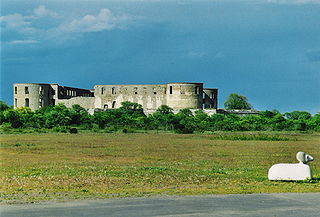
Borgholm Castle in Borgholm, Sweden, is today only a ruin of the fortress that was first built in the second half of the 13th century and rebuilt many times in later centuries. It is linked to Halltorp estate, to the south. The castle was destroyed in a fire on 14 October 1806.

Kronoberg Castle is a medieval ruined castle (slottsruin) located on an island in Helgasjön, 5 kilometres (3.1 mi) north of Växjö in Kronoberg County, which is named after the castle. The castle ruin used to be open to tourists in the summer months, but is permanently closed to tourists since January 2023 due to lack of maintenance.

Alnarp Castle is located in Alnarp, Lomma Municipality, Scania, approximately 10 km north of Malmö in southern Sweden. The original castle on the property was built in the 12th century. The present building was erected in 1862, in French Renaissance style.

Povel Ottesen Huitfeldt was the first Danish-Norwegian Governor-general of Norway.
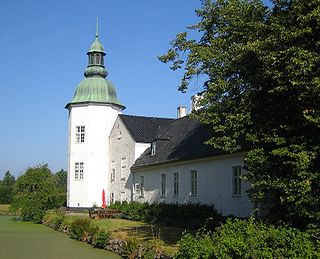
Osbyholm Castle is a castle at Hörby Municipality in Scania, Sweden.
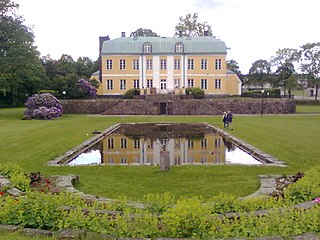
Wapnö Castle is located in Vapnö parish in Halmstad Municipality, Halland, Sweden. The main building houses a restaurant and conference center. The estate comprises 1400 hectares of productive agricultural land and 433 hectares of forest land. The main activity of the estate is milk production and operation of a dairy.
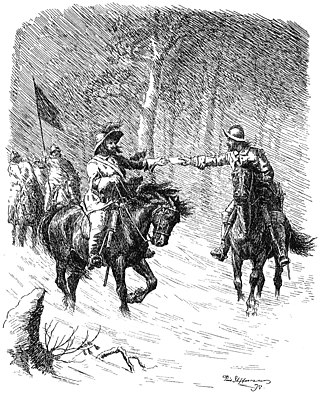
Svend Poulsen, also referred to as Svend Poulsen Gønge was a Danish military commander in the 17th century, serving in the armies of Christian IV, Frederick III, and Christian V. He fought in the Torstenson War, Second Northern War, and the Scanian War, and led the snaphane militia in guerilla warfare against Sweden in occupied Zealand from 1658 to 1659. He was popularized under the name Gøngehøvdingen in 1853, when his exploits were fictionalized under that name by Danish author Carit Etlar. The historicity of his aliases has since been disputed.
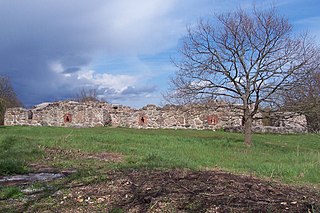
Lyckeby is a village in Karlskrona Municipality, Blekinge County, in southeastern Sweden, near the mouth of the Lyckeby River. The town was originally known as Lyckå.

Iver Krabbe was a Danish nobleman, military officer, and governor-general in Norway.

Norre Port, also Norreport, city gate in Halmstad, Halland County, Sweden. Norre Port was completed in 1601 under the Danish king Christian IV. This was part of the city's fortifications, which also included Halmstad Castle and the ramparts you can see remnants of in Norre Katt's park and by Charles XI's road. The gate, which leads to the street called Storgatan, is angled in relation to this, a way to prevent shelling towards the city.

Älvsborg, now generally known as Old Älvsborg or Älvsborg Castle to distinguish it from the later New Älvsborg and Älvsborg Fortress, was a medieval castle situated on the rocky outcrop known as Klippan, on the south bank of the Göta Älv river within the urban area of the modern city of Gothenburg. It was demolished in the late seventeenth century, but some of its ruins are still visible today, close to the southern pylon of the Älvsborg Bridge.
























